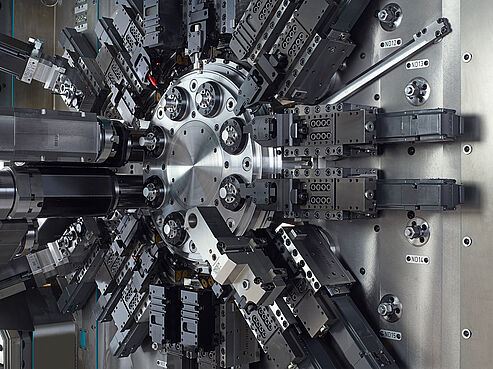Multi-spindle vs sliding head lathes

CNC lathes can offer a wide range of benefits to any machine shop. However, more advanced variations like sliding head lathes and multi-spindle lathes take these benefits to a new level. These machines can dramatically improve overall productivity and, as a result, increase profitability. After all, by maximising the time your machine is online, you can reduce your cost per hour. Deciding which of these machines is best suited to a specific application can be challenging as at first glance their fundamental capabilities seem similar, even though their underlying technology is so different.
This article will explain how each of these machines works and how best to leverage their unique advantages to make the most return from your machine investment, and sooner.
What is a sliding head lathe?
A sliding head lathe is often called a Swiss lathe due to its historical origins as a manufacturer of small precision parts for the Swiss watchmaking industry. These machines are different to traditional lathes in the sense that they feed material through the spindle whilst the tools engage the material radially or axially. Various tool holding systems are arranged around the spindle, facilitating the rapid deployment of different tools as the process evolves. Multiple set-ups take time and can increase both your hourly cost, and the risk of errors which can prove expensive to remedy. The introduction of a large number of different tools, across several tool holding systems, be they plattens or turrets, often allows for part completion in a single operation. In spite of the additional investment, a sliding head lathe can actually reduce your long-term costs for these reasons.
Benefits of sliding head lathes
One of the key advantages of a sliding head lathe is the inherent stiffness in the way the material is machined. As the material is fed into the working area, each tool can engage with said material in close proximity to the main spindle collet, thereby maximising the rigidity of the working process. If the part becomes excessively long then a sub-spindle will grip the part, which is then supported on both sides.
Applications for sliding head lathes
Sliding head lathes are well suited to long, thin and complex parts with large production runs. Parts with a length to diameter ratio of 20:1 can be manufactured on these machines. In addition to this, multiple live tools can be set up to allow for drilling or even milling operations. Sliding head lathes can engage the material with several tools at once, improving productivity and enhancing the potential to reduce the number of costly set-ups.
What is a multi-spindle lathe?
As its name suggests, a multi-spindle lathe is a machine equipped with several spindles, normally six but, in increasing number, up to eight. Each of the spindles is housed within the spindle drum, as the drum rotates each spindle is delivered to a new set of tools where subsequent operations take place. With each spindle loaded with material, all operations take place simultaneously, rather than sequentially (as would be the case on a Sliding Head machine). This allows for unprecedented production rates, which have the potential to bring more revenue to your business.
Benefits of multi-spindle lathes
A multi-spindle lathe allows the creation of complex, multi-feature parts, where the cycle time is dictated by the longest single tool operation, plus the time it takes to rotate the drum. In short, it will use the same cutting data and techniques to produce an individual part, as would be employed on a Sliding or Fixed head CNC lathe, but all operations will take place at the same time, rather than one after the other. The productivity gain is a game changer.

Applications for multi-spindle lathes
Multi-spindle lathes work well with complex, multi-feature parts with a length-to-diameter ratio of up to 4:1, i.e. relatively short parts. These lathes excel at manufacturing parts at a high rate as multiple parts are being cut at the same time, thus reducing overall manufacturing time and maximising your output potential. The number of parts coming off the machine per unit of time is significantly higher than that of a sliding head lathe. Multi-spindle lathes are often thought to only be beneficial when high-quantity runs are required. However, due to changing technology, this is no longer the case. Easy tool set-up allows for much-lower production runs whilst still maintaining profitability and efficiency.
Which is better: multi-spindle lathe vs sliding head lathe?
There are many different styles of CNC lathes on the market. Interestingly the two different technologies mentioned in this paper are frequently employed to make the same parts. There can be no doubt, when it comes to the machining of long, slender parts, the Sliding Head is unrivalled. However many short parts are produced on these machines and it is in this specific area where the maths of the Multi-Spindle becomes compelling. Sliding head lathes often require higher quality bar stock, as the guide bushing is very sensitive to dimensional inconsistency, and will always produce a far longer bar remnant. They lack spindle power, and as we have seen, individual tool paths are more often that not sequential, they are much slower when compared to the more powerful multi-spindle lathes.
To learn more about which machine is better suited to your unique machining requirements, contact a Kingsbury representative today.